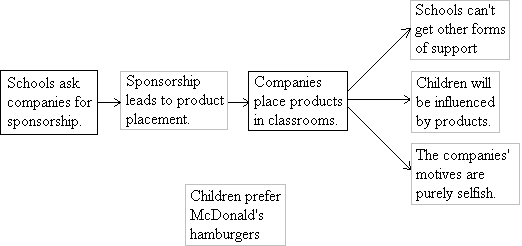AssumptionsA short passage of text is given which draws a conclusion. You are then asked to identify an assumption that is implied in the passage but not stated. The question then asks you to identify which assumption is hiding just beneath the level of the text. Here is an example question: More and more nowadays schools in Britain are being sponsored by commercial companies. Macdonald's for example, has been approached to provide money for school equipment, repairs to buildings, and eventually, presumably, teachers' salaries. This blatant propaganda and brain-washing of the children can only lead to an increase in direct product placement. There is one test that we can apply that is sure to work - the Denial Test. This says, Negate the assumption (i.e. assume that the opposite to the assumption is true), then see if the logical conclusion still holds. If it doesn't - i.e. if the logical conclusion now falls apart - then the original assumption was essential to the conclusion. Let's tackle all those statements, bearing the Denial Test in mind: Children prefer MacDonald's hamburgers to any other on the market. This answer can be quite easily dismissed. The argument in the text doesn't rely on the preferences of children. Indeed, it would still be valid if children hated McDonald's hamburgers. The argument is about sponsorship of schools. Usually, these sorts of questions have one of the options that can be easily dismissed. The others won't be so easy. What does the Denial Test say about this one? Let's reverse the option: Children don't prefer McDonald's Hamburgers. Well, this doesn't affect the argument at all, so it can't be the underlying assumption. Schools cannot get sponsorship from any source other than commercial companies. This is a sneaky one! We might assume that this was the case, since if schools were adequately supported by the government or some other official body, why would they need to turn to commercial companies. However, this is not the point of the argument. The point is that turning to commerical companies leads to product placement. The Denial test again: Schools can get sponsorship from other sources. Again, this does not destroy the argument, as it only refers to the companies' actions once they have been accepted into the schools. Keep this second option in mind. If we can't find a better answer amongst the remaining options, then we can come back to this one. Children will be influenced by the products that companies try to introduce into schools. This one is even better. Presumably, the commercial companies would push their products in the schools in the hope of interesting children (Who was it who said "Grab 'em while they're young!"?) I think this takes the "best option yet" slot, but let's check the others. The Denial test: Children won't be influenced by the products companies introduce into schools. This is almost enough to destroy the argument, which underlines the fact that it is our best choice yet. Even so, the argument does not imply that the children will be influenced, just that the companies will try to place the products in the first place. The companies' motives for increasing school sponsorship are purely selfish. This is another good option, probably as good as the previous one. Still, I don't like that word "purely". The companies may have good motives - helping the children - as well as selfish ones. The Denial Test: The companies' motives are not purely selfish. This leaves the original assumption intact. See the comment when the previous option was fed through the Denial Test. Any companies that agree to sponsorship will automatically use it as an opportunity for product placement. Ah, this is the missing link in the argument! The author starts by stating that schools are turning to companies for sponsorship. Then the record needle jumps a groove, and the author mentions the unacceptable product placement. How did we get from sponsorship to product placement? The missing step must be that the sponsorship will lead to the product placement. What does the Denial Test say about this one?: Companies will not automatically use this as an opportunity to place products in schools. Ah, well, the argument concludes that the product placement will happen, so if we remove the assumption that companies will place products, the whole argument falls done. The Denial Test has successfully spotted the correct option. So the first option is neither here nor there, the next three are things that we might reasonably conclude ourselves from the argument, but not building blocks that the argument relies upon and the last option is the missing stepping stone between the first part of the argument and the last. E is the correct answer:  Exercise 1In each of these questions, there is a small section of text followed by 5 assumptions. You must choose which of the assumptions has to be true for the argument to be a valid one.
|
 Napster was breaking the law by allowing people to download music over the Internet.
Napster was breaking the law by allowing people to download music over the Internet. Allowing people to download music over the Internet would inevitably lead to abuse of that service.
Allowing people to download music over the Internet would inevitably lead to abuse of that service. People have to download music over the Internet as they cannot afford the prices of records and CDs in the shops.
People have to download music over the Internet as they cannot afford the prices of records and CDs in the shops. The record companies make a large amount of profit on the legal sales of music records and CDs.
The record companies make a large amount of profit on the legal sales of music records and CDs. Downloading material and information over the Internet is inherently immoral.
Downloading material and information over the Internet is inherently immoral.

 Go back
Go back